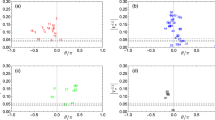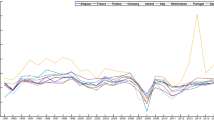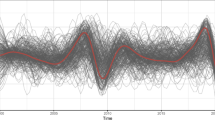Abstract
The present work applies singular spectrum analysis (SSA) to the study of macroeconomic fluctuations in three European countries: Italy, The Netherlands, and the United Kingdom. This advanced spectral method provides valuable spatial and frequency information for multivariate data sets and goes far beyond the classical forms of time domain analysis. In particular, SSA enables us to identify dominant cycles that characterize the deterministic behavior of each time series separately, as well as their shared behavior. We demonstrate its usefulness by analyzing several fundamental indicators of the three countries’ real aggregate economy in a univariate, as well as a multivariate setting. Since business cycles are international phenomena, which show common characteristics across countries, our aim is to uncover supranational behavior within the set of representative European economies selected herein. Finally, the analysis is extended to include several indicators from the U.S. economy, in order to examine its influence on the European economies under study and their interrelationships.








Similar content being viewed by others
Notes
Quarterly national accounts are compiled according to the European System of Accounts (ESA95). Data are available from EUROSTAT at http://epp.eurostat.ec.europa.eu.
In 2008, the ratio of imports to GDP was around 28 % for Italy, 34 % for the UK, and 77 % for The Netherlands. The exports were about 28, 29, and 84 % of GDP, respectively.
In 2000, the UK exported to the U.S. 15.4 % of its total exports and imported from it 13.2 % of its total imports, while Italy exported 14.5 % of its total to Germany and imported 17.7 % from it, cf. Feenstra et al. (2005).
For instance, Italian collective agreements involve very complex firing procedures for firms that have more than 15 workers. As a consequence, both medium- and large-size firms are strongly discouraged from modifying their employment level.
All series are expressed in constant year-2000 Euros. They are seasonally adjusted and corrected by working days, following the TRAMO-SEATS procedure (Maravall 2005).
Plotting the eigenvalues against their rank, as originally proposed by Vautard and Ghil (1989), is more useful in distinguishing between signal and noise. In identifying and statistically testing for oscillatory modes, as we do here, it is more informative to plot the eigenvalues versus the associated frequency of the corresponding eigenvectors (cf. Allen and Smith 1996).
Note that the chance of not being significant increases with the period length.
References
Aadland, D. (2005). Detrending time-aggregated data. Economic Letters, 89, 287–293.
A’Hearn, B., & Woitek, U. (2001). More international evidence on the historical properties of business cycles. Journal of Monetary Economics, 47, 321–346.
Allen, M., & Robertson, A. (1996). Distinguishing modulated oscillations from coloured noise in multivariate datasets. Climate Dynamics, 12, 775–784.
Allen, M. R., & Smith, L. A. (1996). Monte Carlo SSA: Detecting irregular oscillations in the presence of colored noise. Journal of Climate, 9, 3373–3404.
Artis, M. J. (2003). Is there a European business cycle. Working Paper 1053, CESifo Group Munich.
Atesoglu, H. S., & Vilasuso, J. (1999). A band spectral analysis of exports and economic growth in the United States. Review of International Economics, 7, 140–152.
Baxter, M., & King, R. G. (1999). Measuring business cycles: Approximate band-pass filters for economic time series. Review of Economics and Statistics, 81, 575–593.
Baxter, M., & Kouparitsas, M. A. (2005). Determinants of business cycle movement: A robust analysis. Journal of Monetary Economics, 52, 113–1157.
Blackman, R. B., & Tukey, J. W. (1958). The measurement of power spectra from the point of view of communication engineering. Mineola: Dover Publications.
Blanchard, O. J., & Watson, M. W. (1984). Are business cycles all alike? Working Paper w1392. National Bureau of Economic Research.
Broomhead, D. S., & King, G. (1986a). Extracting qualitative dynamics from experimental data. Physica D, 20, 217–236.
Broomhead, D. S., & King, G. P. (1986b). On the qualitative analysis of experimental dynamical systems. In S. Sarkar (Ed.), Nonlinear phenomena and chaos (pp. 113–144). Bristol: Adam Hilger.
Calderon, C., Chong, A., & Stein, E. (2007). Trade intensity and business cycle synchronization: Are developing countries any different? Journal of International Economics, 71(1), 2–21.
Chiarella, C., Flaschel, P., & Franke, R. (2005). Foundations for a disequilibrium theory of the business cycle: Qualitative analysis and quantitative assessment. Cambridge: Cambridge University Press.
Christiano, L. J., & Fitzgerald, T. J. (2003). The band pass filter. International Economic Review, 44(2), 435–465.
Coe, D., & Helpman, E. (1995). International R&D spillovers. European Economic Review, 39(7), 859–887.
Cogley, T., & Nason, J. M. (1995). Effects of the Hodrick–Prescott filter on trend and difference stationary time series: Implications for business cycle research. Journal of Economic Dynamics and Control, 19(1–2), 253–278.
Croux, C., Forni, M., & Reichlin, L. (2001). A measure of comovement for economic variables: Theory and empirics. Review of Economics and Statistics, 83(2), 232–241.
de Carvalho, M., Rodrigues, P. C., & Rua, A. (2012). Tracking the US business cycle with a singular spectrum analysis. Economics Letters, 114(1), 32–35.
De Haan, J., Inklaar, R., & Jong-A-Pin, R. (2008). Will business cycles in the Euro area converge? A critical survey of empirical research. Journal of Economic Surveys, 22(2), 234–273.
De Haan, J., Inklaar, R., & Sleijpen, O. (2002). Have business cycles become more synchronized? Journal of Common Market Studies, 40(1), 23–42.
Den Haan, W. J., & Sumner, S. (2001). The comovement between real activity and prices in the G7. Working Paper 8195. National Bureau of Economic Research.
Dickerson, A., Gibson, H., & Tsakalotos, E. (1998). Business cycle correspondence in the European Union. Empirica, 25(1), 51–77.
Dumas, P., Ghil, M., Groth, A., & Hallegatte, S. (2014) Dynamic coupling of the climate and macroeconomic systems. Mathematics of the Social Sciences (in press).
Esping-Andersen, G. (1999). Social foundations of postindustrial economies. Oxford: Oxford University.
Eurostat. (2002). Economic portrait of the European Union 2001. Panorama of the European Union, European Commission.
Feenstra, R. C., Lipsey, R. E., Deng, H., Ma, A. C., & Mo, H. (2005). World trade flows: 1962–2000. Working paper 11040, National Bureau of Economic Research.
Frankel, J. A., & Rose, A. K. (1998). The endogeneity of the optimum currency area criteria. Economic Journal, 25, 1009–1025.
Ghil, M., Allen, M. R., Dettinger, M. D., Ide, K., Kondrashov, D., Mann, M. E., et al. (2002). Advanced spectral methods for climatic time series. Reviews of Geophysics, 40(1), 1–41.
Ghil, M., & Vautard, R. (1991). Interdecadal oscillations and the warming trend in global temperature time series. Nature, 350, 324–327.
Golyandina, N., Nekrutkin, V., & Zhigliavsky, A. (2001). Analysis of time series structure: SSA and related techniques. Boca Raton: Chapman & Hall/CRC.
Golyandina, N., & Zhigljavsky, A. A. (2013). Singular spectrum analysis for time series. Berlin: Springer.
Graff, M. (2011). International business cycles: How do they relate to Switzerland? Technical rep. 291, KOF Swiss Economic Institute, ETH Zurich working paper.
Granger, C. W. (1966). The typical spectral shape of an economic variable. Econometrica, 34(1), 150–161.
Granger, C. W. (1969). Investigating causal relations by econometric models and cross-spectral methods. Journal of the Econometric Society, 37(3), 424–438.
Granger, C. W. J., & Hatanaka, M. (1964). Spectral analysis of economic time series. Princeton: Princeton University Press.
Groth, A., Dumas, P., Ghil, M., & Hallegatte, S. (2015a). Impacts of natural disasters on a dynamic economy. In E. Chavez, M. Ghil, & J. Urrutia-Fucugauchi (Eds.), Extreme events : Observations, modeling, and economics (p. 438). London: American Geophysical Union and Wiley-Blackwell.
Groth, A., & Ghil, M. (2011). Multivariate singular spectrum analysis and the road to phase synchronization. Physical Review E, 84, 036206.
Groth, A., Ghil, M., Hallegatte, S., & Dumas, P. (2012). The role of oscillatory modes in U.S. business cycles. Working paper 26, Fondazione Eni Enrico Mattei (FEEM).
Groth, A., Ghil, M., Hallegatte, S., & Dumas, P. (2015b). The role of oscillatory modes in U.S. business cycles. OECD Journal: Journal of Business Cycle Measurement and Analysis, 2015(1), 63–81.
Groth, A., & Ghil, M. (2015c). Monte Carlo Singular Spectrum Analysis (SSA) revisited: Detecting oscillator clusters in multivariate datasets. Journal of Climate, 28, 7873–7893.
Gruben, W., Koo, J., & Millis, (2002). How much does international trade affect business cycles synchronization? Working Paper 0203. Federal Reserve Bank of Dallas.
Hallegatte, S., Ghil, M., Dumas, P., & Hourcade, J. (2008). Business cycles, bifurcations and chaos in neo-classical model with investment dynamics. Journal of Economic Behaviour and Organization, 67, 57–77.
Higo, M., & Nakada, S. K. (1998). How can we extract a fundamental trend from an economic time-series? Monetary and Economic Studies, 16(2), 61–111.
Hodrick, R. J., & Prescott, E. C. (1997). Postwar U.S. business cycles: An empirical investigation. Journal of Money, Credit and Banking, 29(1), 1–16.
Iacobucci, A. (2003) Spectral analysis for economic time series. Working papers 07, OFCE.
Imbs, J. (2004). Trade, finance, specialization, and synchronization. Review of Economics and Statistics, 86(3), 723–734.
Inklaar, R., & De Haan, J. (2001). Is there really a European business cycle? A comment. Oxford Economic Review, 53, 215–220.
Juglar, C. (1862). Des crises commerciales et de leur retour périodique, en France, en Angleterre et aux États Unis. Paris: Alcan.
Kalemli-Ozcan, S., Sørensen, B., & Yosha, O. (2001). Economic integration, industrial specialization, and the asymmetry of macroeconomic fluctuations. Journal of International Economics, 55(1), 107–137.
Keppenne, C. L., & Ghil, M. (1993). Adaptive filtering and prediction of noisy multivariate signals: An application to subannual variability in atmospheric angular momentum. International Journal of Bifurcation and Chaos, 3, 625–634.
King, R., & Rebelo, S. (2000). Resuscitating real business cycles. Working paper 7534, National Bureau of Economic Research.
King, R., & Watson, M. (1996). Money, prices, interest rates and the business cycles. Review of Economics and Statistics, 78, 35–53.
Kitchin, J. (1923). Cycles and trends in economic factors. The Review of Economic Statistics, 5, 10–16.
Kontolemis, Z. (1997). Does growth vary over the business cycle? Some evidence from the G7 countries. Economica, 64, 441–460.
Kose, M. A., Otrok, C., & Whiteman, C. H. (2003) International business cycles: World, region, and country-specific factors. American Economic Review, 1216–1239.
Krugman, P. (1993). Lessons of Massachusetts for EMU. In F. Giavazzi & G. Torres (Eds.), The transition to economic and monetary union (pp. 41–61). New York: Cambridge University Press.
Kydland, F. E., & Prescott, E. C. (1982). Time to build and aggregate fluctuations. Econometrica, 50(6), 1345–1370.
Lisi, F., & Medio, A. (1997). Is a random walk the best exchange rate predictor? International Journal of Forecasting, 13, 255–267.
Long, J. B, Jr., & Plosser, C. (1983). Real business cycles. The Journal of Political Economy, 91(1), 39–69.
Lumsdaine, R. L., & Prasad, E. S. (2003). Identifying the common component of international economic fluctuations: A new approach. The Economic Journal, 113(484), 101–127.
Mañé, R. (1981). On the dimension of the compact invariant sets of certain non-linear maps. In Dynamical systems and turbulence. Vol. 898 of lecture notes in mathematics (pp. 230–242). Berlin: Springer
Maravall, A. (2005). An application of the TRAMO-SEATS automatic procedure: Direct versus indirect adjustment. Working Paper 0524, Bank of Spain.
Mazzi, G., & Savio, G. (Eds.). (2006). Growth and cycle in the Euro-Zone. Basingstoke: Palgrave McMillan.
Nelson, C. R., & Kang, H. (1981). Spurious periodicity in inappropriately detrended time series. Econometrica, 49(3), 741–751.
Otto, G., Voss, G., & Willard, L. (2001). Understanding OECD output correlations. Economic Research Department, Reserve Bank of Australia.
Penland, C. (1989). Random forcing and forecasting using principal oscillation pattern analysis. Monthly Weather Review, 117, 2165–2185.
Pikovsky, A., Rosenblum, M., & Kurths, J. (2003). Synchronization: A universal concept in nonlinear science. Cambridge: Cambridge University Press.
Plaut, G., & Vautard, R. (1994). Spells of low-frequency oscillations and weather regimes in the Northern Hemisphere. Journal of the Atmospheric Sciences, 51(2), 210–236.
Pollock, D. (2014). Cycles, syllogisms and semantics: Examining the idea of spurious cycles. Journal of Time Series Econometrics, 6(1), 81–102.
Sella, L. (2008). Old and new spectral techniques for economic time series. U. of Torino Department of Economics Research Paper 9.
Sella, L., & Marchionatti, R. (2012). On the cyclical variability of economic growth in Italy, 1881–1913: A critical note. Cliometrica, 6(3), 307–328.
Solow, R. (1956). A contribution to the theory of economic growth. The Quarterly Journal of Economics, 70, 6594.
Stanca, L. M. (1999). Are business cycles all alike? Evidence from long-run international data. Applied Economics Letters, 6, 765–769.
Stock, J. H., & Watson, M. W. (2002). Has the business cycle changed and why? Macroeconomic Annual, National Bureau of Economic Research.
Stock, J. H., & Watson, M. W. (2005). Understanding changes in international business cycle dynamics. Journal of the European Economic Association, 3(5), 966–1006.
Sussmuth, B. (2002). National and supranational business cycles (1960–2000): A multivariate description of central G7 and EUR015 NIPA aggregates. ifo Studien 48.
Takens, F. (1981). Detecting strange attractors in turbulence. In Dynamical systems and turbulence. Vol. 898 of lecture notes in mathematics. (pp. 366–381). Berlin: Springer.
Vautard, R., & Ghil, M. (1989). Singular spectrum analysis in nonlinear dynamics, with applications to paleoclimatic time series. Physica D, 35, 395–424.
Vautard, R., Yiou, P., & Ghil, M. (1992). Singular-spectrum analysis: A toolkit for short, noisy chaotic signals. Physica, 58, 95–126.
Von Storch, H. (1995). Inconsistencies at the interface between climate research and climate impact studies. Meteorologische Zeitschrift, 4, 72–80.
Wang, P. (2013). Business cycle phases and coherence? A spectral analysis of UK sectoral output. The Manchester School, 81(6), 1012–1026.
Woitek, U. (1996). The G7-countries: A multivariate description of business cycle stylized facts. In W. Barnett, G. Gandolfo, & C. Hillinger (Eds.), Dynamic disequilibrium modelling: Theory and applications (pp. 283–309). Cambridge: Cambridge University Press.
Zarnowitz, V. (1985). Recent work on business cycles in historical perspective: A review of theories and evidence. Journal of Economic Literature, 23(2), 523–580.
Acknowledgments
We would like to thank Pietro Terna and Vittorio Valli for their valuable guidance to the two lead authors and for their many suggestions about the economic interpretation of this work’s results. AG acknowledges support from the Groupement d’Intérêt Scientifique (GIS) Réseau de Recherche sur le Développement Soutenable (R2DS) of the Région Ile-de-France while affiliated with the Environmental Research and Teaching Institute at the Ecole Normale Supérieure in Paris. AG and MG both received support from NSF grant OCE-1243175, as well as from ONR MURI Grant N00014-12-1-0911.
Author information
Authors and Affiliations
Corresponding author
Rights and permissions
About this article
Cite this article
Sella, L., Vivaldo, G., Groth, A. et al. Economic Cycles and Their Synchronization: A Comparison of Cyclic Modes in Three European Countries. J Bus Cycle Res 12, 25–48 (2016). https://doi.org/10.1007/s41549-016-0003-4
Received:
Accepted:
Published:
Issue Date:
DOI: https://doi.org/10.1007/s41549-016-0003-4




